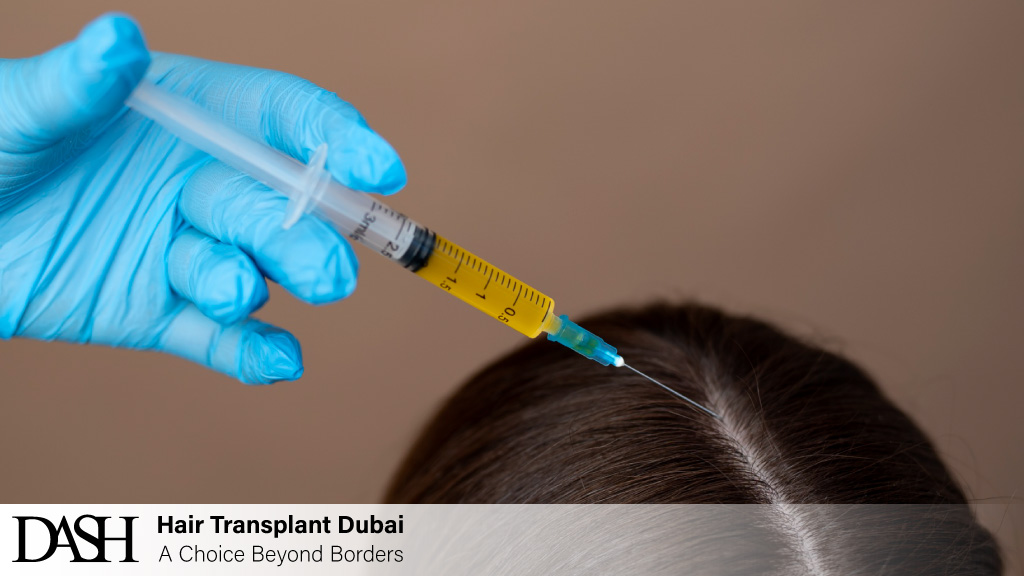Growth Factor Injections vs. PRP | Which Works Better for Hair Loss?

Hair loss affects millions of people worldwide and can have a significant emotional and psychological impact. While there are many treatment options available, two of the most talked-about non-surgical solutions today are PRP (Platelet-Rich Plasma) therapy and growth factor injections. Both aim to stimulate hair regrowth, but they do so in different ways—and often, patients are left wondering: Which one works better?
In this comprehensive guide, we’ll compare PRP and growth factor injections side by side to help you make an informed decision.
What Is PRP (Platelet-Rich Plasma) Therapy?
PRP therapy involves drawing a small amount of the patient’s blood, processing it in a centrifuge to concentrate the platelets, and injecting that platelet-rich plasma back into the scalp. Platelets are packed with growth factors and proteins that stimulate healing and regeneration in the body—including dormant hair follicles.
Key Mechanisms:
- Boosts blood flow to hair follicles
- Activates stem cells around the follicles
- Encourages the growth of thicker, healthier hair
- Reduces shedding by revitalizing weakened follicles
PRP uses your body’s own biological material, which makes it a natural, low-risk treatment.
What Are Growth Factor Injections?
Growth factor injections are a newer development in the hair restoration field. Instead of using your own blood, they use lab-engineered or extracted peptides, cytokines, and growth factors, often derived from plant cells, synthetic biology, or sometimes human stem cells.
How They Work:
- Deliver a targeted dose of bio-identical growth factors directly into the scalp
- Promote hair regeneration by stimulating follicle activity
- Often combined with microneedling or mesotherapy for better absorption
Because these are lab-produced, growth factor injections provide a controlled and concentrated dose of specific regenerative molecules.
PRP vs. Growth Factor Injections: Head-to-Head Comparison
Let’s break down the key differences between these two treatments across several critical areas.
1. Source of Healing Compounds
- PRP: Derived from your own blood (autologous)
- Growth Factors: Lab-produced or stem-cell-derived (non-autologous)
✅ If you prefer treatments from your own body, PRP is the better choice.
2. Potency and Customization
- PRP: Naturally contains platelets and other components, but concentration levels vary by individual
- Growth Factors: Precisely formulated for maximum regenerative effect
✅ Growth factor injections often deliver a more consistent and potent solution.
3. Speed of Results
- PRP: Results typically appear after 3–6 months of regular sessions
- Growth Factors: Some patients report visible changes as early as 6–8 weeks
✅ Growth factors may provide slightly faster initial results.
4. Longevity of Results
- PRP: Requires maintenance every 4–6 months to sustain results
- Growth Factors: May last longer depending on the formulation and patient response
✅ Both require long-term consistency, but growth factors might offer extended benefits in some cases.
5. Safety and Risk
- PRP: Extremely safe since it’s your own blood—minimal side effects
- Growth Factors: Generally safe but may cause reactions in sensitive individuals
✅ PRP wins in safety due to zero risk of allergic or immune response.
6. Cost of Treatment
- PRP: Moderately priced depending on clinic and location
- Growth Factors: Typically more expensive due to lab production costs
✅ PRP is usually more affordable, especially for multiple sessions.
Which One Is Better for You?
The answer depends on your specific hair loss pattern, health profile, and expectations.
| You May Benefit More from PRP If You… | You May Benefit More from Growth Factors If You… |
|---|---|
| Prefer natural, autologous treatments | Want a higher concentration of regenerative compounds |
| Have early-stage thinning and active follicles | Need faster results or failed other treatments |
| Have allergies or sensitivities to synthetic agents | Don’t mind using lab-derived bio-identical molecules |
In some cases, clinics combine both PRP and growth factors to amplify results—especially in patients with stubborn or advanced hair loss.
Final Verdict
Both PRP and growth factor injections offer powerful tools for combating hair loss without surgery. PRP is time-tested, natural, and widely used, while growth factor therapy represents an exciting new frontier in regenerative medicine.
If you’re new to hair restoration, PRP is a great starting point. If you’ve tried PRP and want to take results to the next level—or if you’re looking for a more potent approach—growth factors might be worth exploring.
Frequently Asked Questions (FAQ)
❓ Can I combine PRP and growth factor injections?
Yes. Many specialists now offer combination protocols using both PRP and lab-derived growth factors for a synergistic effect. This approach can boost follicle activation and speed up results.
❓ Are growth factors safe for everyone?
Most are considered safe, but individuals with autoimmune diseases or very sensitive skin should consult their doctor first. Some formulations may not be suitable during pregnancy or breastfeeding.
❓ How many sessions do I need?
- PRP: Typically 3–4 sessions initially, followed by maintenance every 4–6 months
- Growth Factors: Usually a 3–session protocol spaced 2–4 weeks apart, with follow-up based on results
❓ Will I lose hair again if I stop treatment?
Yes—just like most hair loss therapies, results may fade over time if maintenance is discontinued. Ongoing sessions are key to sustaining hair growth.
❓ Which one is more painful?
Both treatments are minimally invasive, but some patients report slightly more tenderness with PRP due to multiple small injections. Numbing creams are used to reduce discomfort.